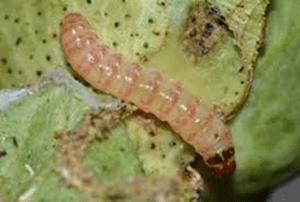TAG: GS 3: ECOLOGY AND ENVIRONMENT
THE CONTEXT: Pink Bollworm (Pectinophora gossypiella) is a significant pest affecting cotton crops worldwide, including in India. A recent study has highlighted the impact of rising temperatures on the developmental parameters of this pest, revealing critical insights into how climate change exacerbates agricultural challenges.
EXPLANATION:
Highlights of the study
- The study, titled Effect of temperature on the biological parameters of pink bollworm, Pectinophora gossypiella Saunders (Lepidoptera: Gelechiidae), was published in the Nature journal on July 1.
- It explores the thermal fitness of Pink Bollworm and its implications for pest management amidst climate change.
- The researchers investigated how varying temperatures affect the life cycle and survival of P. gossypiella.
- Key observations included:
- Shortened Developmental Period: At 40°C, the pest’s developmental cycle from egg to adult was significantly shorter (26.09 ± 3.24 days) compared to at 20°C (42.74 ± 3.12 days).
- Increased Generations: Higher temperatures enable more generations to complete within a season, potentially increasing infestation rates.
- Egg Hatchability and Larval Survival: Optimal egg hatchability (81.2%) and larval survival (86.7%) were recorded at 30°C, with lower rates at both higher and lower temperatures.
- Pupal Weight and Adult Emergence: Higher temperatures (30-35°C) resulted in increased pupal weight, higher adult emergence, and improved mating success, leading to greater offspring production.
- Developmental Duration: The mean duration for egg, larval, and pupal stages was significantly longer at 20°C, with larval development time decreasing as temperatures rose.
- Adult Longevity: Adult lifespan decreased with increasing temperatures, though females consistently outlived males.
- The findings align with previous research, noting higher larval mortality of Spodoptera frugiperda and P. gossypiella at extreme temperatures (18 and 37°C).
- Additionally, mating success was highest at 30-35°C, indicating that these temperatures optimize reproductive success for the pest.
- The study also revealed that P. gossypiella can mitigate thermal stress and gradually recover over generations by adjusting certain developmental traits, allowing it to thrive in diverse environments.
Implications of the Findings
- Global temperatures are projected to rise between 1.5 and 4.5°C by 2100, significantly impacting agricultural ecosystems.
- Changes in temperature, humidity, rainfall, and photoperiod can influence the physiological responses of pests like P. gossypiella, altering their population dynamics and increasing their threat to crops.
- The study’s insights are crucial for developing climate-resilient pest management strategies.
- Understanding how temperature affects pest development helps in predicting population dynamics and implementing timely interventions to protect crops.
Impact on Cotton Yields in India
- gossypiella has caused substantial damage to cotton fields in India, with yield losses up to 68% among both Bt-cotton and non-Bt cultivars.
- Field reports in October 2023 from Rajasthan, Punjab, and Haryana indicated damages as high as 90%.
- Recent years have seen outbreaks of P. gossypiella in central and northern India, influenced by changing climatic conditions.
- The lack of detailed information on the thermal effects on the pest’s life history traits and transgenerational impacts underscores the need for further research and adaptive management practices.
PINK BOLLWORM:
- It is a major pest of cotton, causing significant yield losses worldwide.
- It is originally native to India but now it is recorded in nearly all the cotton-growing countries of the world.
- The larvae of the pink bollworm bore into cotton bolls, feeding on the developing seeds. This can result in significant yield losses, as well as reduced seed quality.
- It is one of the most destructive pests of cotton.
- Pectinophora gossypiella is its scientific name.

- The adults are small moths about 3/8 inch long and are dark brown with markings on the fore wing.
- The larval stage is the destructive and identifiable stage.
- The larvae have distinctive pink bands and can reach a length of ½ inches right before they pupate.
ECOLOGICAL THREAT:
- Pink bollworms are major pests of cotton.
- Adults only last for 2 weeks, but females will lay 200 or more eggs.
- Adults lay eggs on cotton bolls; once hatched, the larvae eat the seeds and damage the fibers of the cotton, reducing the yield and quality.
- When the larvae mature, they cut out the boll and drop to the ground and cocoon near the soil surface.
- It has also been observed to attack hibiscus, okra, and hollyhock plants.
BT COTTON:
- Bt cotton has been genetically modified by the insertion of one or more genes from a common soil bacterium, Bacillus thuringiensis.
- These genes encode for the production of insecticidal proteins, and thus, genetically transformed plants produce one or more toxins as they grow.
- The genes that have been inserted into cotton produce toxins that are limited in activity almost exclusively to caterpillar pests (Lepidoptera).
- However, other strains of Bacillus thuringiensis have genes that encode for toxins with insecticidal activity on some beetles (Coleoptera) and flies (Diptera).
- Some of these genes are being used to control pests in other crops, such as corn.
BENEFITS OF BT COTTON:
- Increased yields
- Reduced insecticide use
- Improved fiber quality
- Reduced environmental impact
- Increased farmer income

